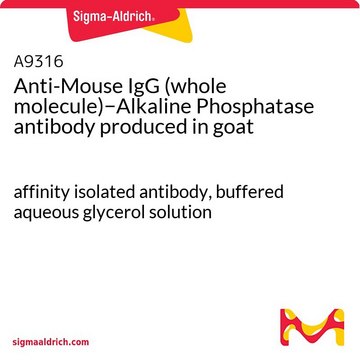D7679
3,3′-Diaminobenzidine (DAB) Liquid Substrate Dropper System
liquid
Iniciar sesiónpara Ver la Fijación de precios por contrato y de la organización
About This Item
Número de CAS:
EC Number:
MDL number:
UNSPSC Code:
12352204
PubChem Substance ID:
NACRES:
NA.75
Productos recomendados
form
liquid
Quality Level
technique(s)
immunoblotting: suitable
solubility
water: soluble
shipped in
wet ice
storage temp.
2-8°C
SMILES string
Cl.Cl.Cl.Cl.Nc1ccc(cc1N)-c2ccc(N)c(N)c2
InChI
1S/C12H14N4.4ClH/c13-9-3-1-7(5-11(9)15)8-2-4-10(14)12(16)6-8;;;;/h1-6H,13-16H2;4*1H
InChI key
KJDSORYAHBAGPP-UHFFFAOYSA-N
General description
DAB (3,3′-Diaminobenzidine Tetrahydrochloride) Liquid Substrate Dropper System has been developed for use in immunohistology and immunoblotting procedures as a precipitating substrate for the detection of peroxidase activity. DAB is the immunohistology substrate of choice because it produces an intense brown stain that is easily observed. The end product is resistant to alcohol, therefore, a variety of counterstains and mounting media can be used with the DAB Liquid Substrate Dropper System. DAB Liquid Substrate Dropper System provides all of the chromogen and buffer/peroxide solutions needed to produce a fast and convenient DAB substrate solution.
Application
3,3′-Diaminobenzidine (DAB) Liquid Substrate Dropper System has been used as a developer in immunohistogical examination.
Caution
Stable at least one year at 2-8 °C.
Quantity
Each DAB liquid substrate dropper system will provide ten individual application dropper bottles of 10 mL of a fast and convenient DAB substrate solution.
Solo componentes del kit
Referencia del producto
Descripción
- 10× DAB Liquid Chromogen 10 mL
- premeasured, ready-to-use buffer/peroxide solution for individual application 10 x 9
Storage Class
11 - Combustible Solids
wgk_germany
WGK 3
Certificados de análisis (COA)
Busque Certificados de análisis (COA) introduciendo el número de lote del producto. Los números de lote se encuentran en la etiqueta del producto después de las palabras «Lot» o «Batch»
¿Ya tiene este producto?
Encuentre la documentación para los productos que ha comprado recientemente en la Biblioteca de documentos.
Los clientes también vieron
N M Chu et al.
The journal of histochemistry and cytochemistry : official journal of the Histochemistry Society, 37(2), 257-263 (1989-02-01)
Immunoblotting techniques are widely used for detection of antigen immobilized on nitrocellulose membranes. There are many immunolabeling methods and staining methods available to disclose the presence of antigen in such techniques. Five common staining methods each for alkaline phosphatase and
CD8+ T cells expressing IL-10 are associated with a favourable prognosis in lung cancer
Miotto D, et al.
Lung Cancer, 69(3), 355-360 (2010)
The duality of beta-catenin function: a requirement in lens morphogenesis and signaling suppression of lens fate in periocular ectoderm
Smith AN, et al.
Developmental Biology, 285(2), 477-489 (2005)
Carola W N Damen et al.
Analytical biochemistry, 393(1), 73-79 (2009-06-16)
For the bioanalysis of therapeutic monoclonal antibodies in biological matrices, immunoassays--especially enzyme-linked immunosorbent assays (ELISAs)--are the most widely used techniques. Although ELISAs are very sensitive, the obtained sensitivity is not always sufficient. In this study, we have investigated the possibilities
S M Hsu et al.
The journal of histochemistry and cytochemistry : official journal of the Histochemistry Society, 30(10), 1079-1082 (1982-10-01)
Three metallic ions, NiCl2, CoCl2, and CuSO4, were found to modify the color of the normally brown diaminobenzidine (DAB) reaction. The colors ranged from purplish blue (NiCl2), dark blue/bluish black (CoCl2), to greyish blue (CuSO4). We have found that the
Nuestro equipo de científicos tiene experiencia en todas las áreas de investigación: Ciencias de la vida, Ciencia de los materiales, Síntesis química, Cromatografía, Analítica y muchas otras.
Póngase en contacto con el Servicio técnico








